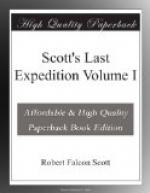Meares and I were able to clamber over the snow to some extent and to examine the neat pile of cases in the middle, but they will take much digging out. We got some asbestos sheeting from the magnetic hut and made the best shelter we could to boil our cocoa.
There was something too depressing in finding the old hut in such a desolate condition. I had had so much interest in seeing all the old landmarks and the huts apparently intact. To camp outside and feel that all the old comfort and cheer had departed, was dreadfully heartrending. I went to bed thoroughly depressed. It stems a fundamental expression of civilised human sentiment that men who come to such places as this should leave what comfort they can to welcome those who follow.
Monday, January 16.—We slept badly till the morning and, therefore, late. After breakfast we went up the hills; there was a keen S.E. breeze, but the sun shone and my spirits revived. There was very much less snow everywhere than I had ever seen. The ski run was completely cut through in two places, the Gap and Observation Hill almost bare, a great bare slope on the side of Arrival Heights, and on top of Crater Heights an immense bare table-land. How delighted we should have been to see it like this in the old days! The pond was thawed and the #confervae green in fresh water. The hole which we had dug in the mound in the pond was still there, as Meares discovered by falling into it up to his waist and getting very wet.
On the south side we could see the Pressure Ridges beyond Pram Point as of old—Horseshoe Bay calm and unpressed—the sea ice pressed on Pram Point and along the Gap ice foot, and a new ridge running around C. Armitage about 2 miles off. We saw Ferrar’s old thermometer tubes standing out of the snow slope as though they’d been placed yesterday. Vince’s cross might have been placed yesterday—the paint was so fresh and the inscription so legible.
The flagstaff was down, the stays having carried away, but in five minutes it could be put up again. We loaded some asbestos sheeting from the old magnetic hut on our sledges for Simpson, and by standing 1/4 mile off Hut Point got a clear run to Glacier Tongue. I had hoped to get across the wide crack by going west, but found that it ran for a great distance and had to get on the glacier at the place at which we had left it. We got to camp about teatime. I found our larder in the grotto completed and stored with mutton and penguins—the temperature inside has never been above 27 deg., so that it ought to be a fine place for our winter store. Simpson has almost completed the differential magnetic cave next door. The hut stove was burning well and the interior of the building already warm and homelike—a day or two and we shall be occupying it.
I took Ponting out to see some interesting thaw effects on the ice cliffs east of the Camp. I noted that the ice layers were pressing out over thin dirt bands as though the latter made the cleavage lines over which the strata slid.




